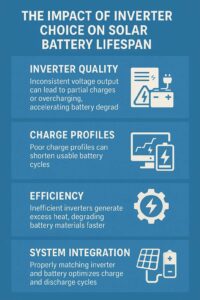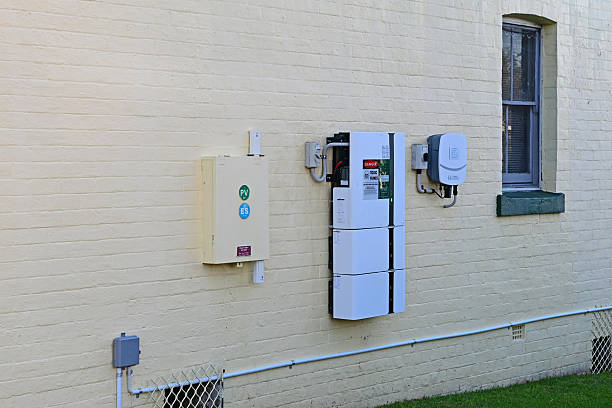Selecting the right inverter is not just a technical detail — it directly affects the usable life of a solar battery system. For property owners investing in solar energy storage, understanding how inverter specifications influence battery degradation is essential for maximising system value and minimising replacement costs.
- Why Inverter Quality Matters for Battery Health
A high-quality inverter ensures that the conversion of DC to AC power is efficient and stable. Inferior inverters may produce inconsistent voltage, frequency fluctuations, or poor waveform quality. This instability forces the battery to work harder, creating heat and chemical stress inside the cells. For anyone installing Solar inverters Perth wide, verifying product certification, warranty terms, & compliance with Australian Standards is the first safeguard against premature battery wear.
- The Role of Charge Profiles
Batteries require precise charging stages: bulk, absorption, and float. Advanced inverters manage these stages automatically. If the inverter’s charge controller fails to maintain correct voltages or time cycles, the battery may stay undercharged or overcharged. Both scenarios cause sulphation, plate corrosion, or thermal runaway over time.
For lithium-ion batteries, correct charge profiles are even more critical. Many manufacturers void battery warranties if paired with incompatible inverters. This highlights the importance of choosing an inverter with programmable or battery-specific profiles.
- Efficiency & Heat Management
Inverter efficiency directly affects battery lifespan. A low-efficiency inverter wastes more power as heat, raising ambient temperatures in the enclosure. Excess heat degrades battery components faster, especially in Perth’s hot climate. Selecting an inverter with a high efficiency rating (typically above 95%) minimises these losses.
Modern hybrid inverters also integrate smart cooling features & thermal management. This stabilises operating conditions for the connected battery bank, reducing wear on cells.

- System Integration: Matching Capacity & Performance
Proper inverter sizing is crucial. An undersized inverter may be forced to operate at full capacity continuously, increasing internal temperatures. An oversized inverter may fail to optimise charging currents, leading to inefficient cycles. Solar designers should ensure the inverter’s output matches the battery’s charge & discharge rates as specified by the manufacturer.
Integrated energy management systems can also coordinate battery use with load demands & solar generation. This balance smooths charge/discharge cycles, preventing deep discharges that shorten battery lifespan.
- The Hidden Cost of Poor Inverter Choice
Choosing a low-grade inverter can reduce a battery’s usable life by years. For example, a well-maintained lithium-ion battery should last 10–15 years. Poor charging control could cut this to 5–7 years — effectively doubling replacement costs. Over the system’s lifetime, the upfront saving on a cheaper inverter is quickly outweighed by early battery replacements.
- Best Practice for Solar Battery Owners
For any property considering a solar battery Perth installation, it’s vital to:
- Source inverters from reputable brands with Australian warranties.
- Ensure the inverter supports the specific battery chemistry.
- Use licensed solar electricians for design & commissioning.
- Regularly update firmware to benefit from charging algorithm improvements.
Conclusion
Inverters do more than convert power — they govern how smoothly & safely your battery charges and discharges every day. The right choice of inverter protects your battery bank, maximises usable storage, & extends system life. For homeowners & businesses alike, investing in proven inverter quality is a decision that safeguards every dollar spent on solar storage.

